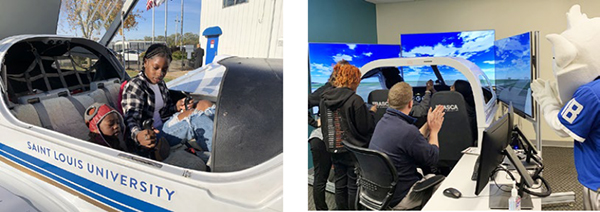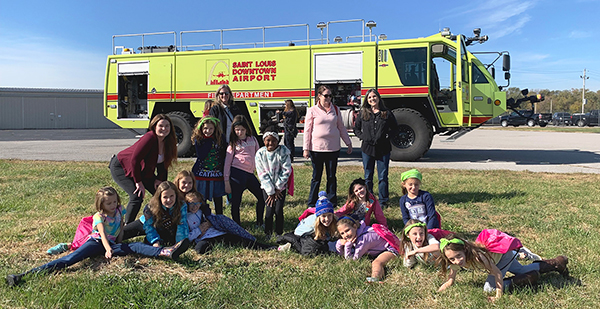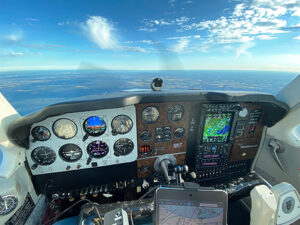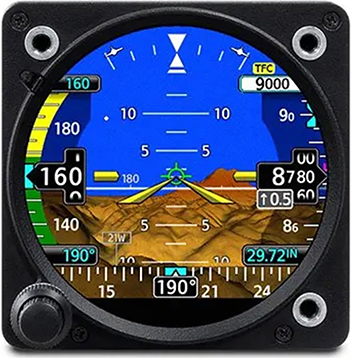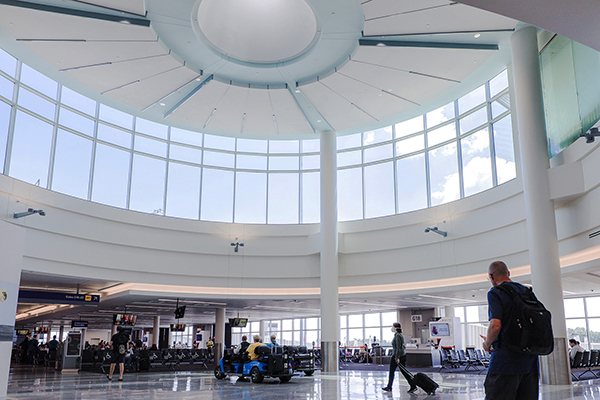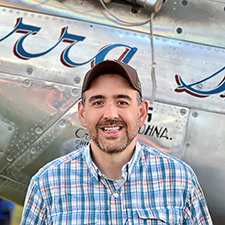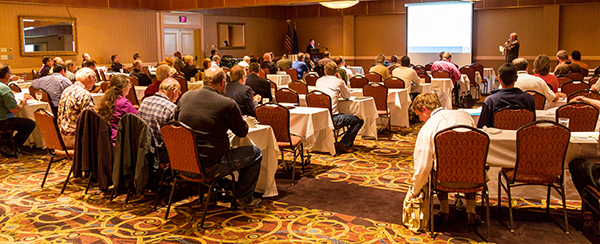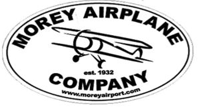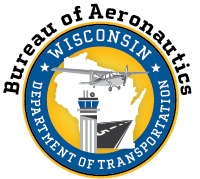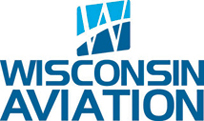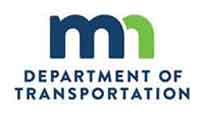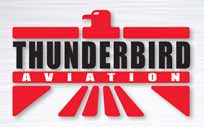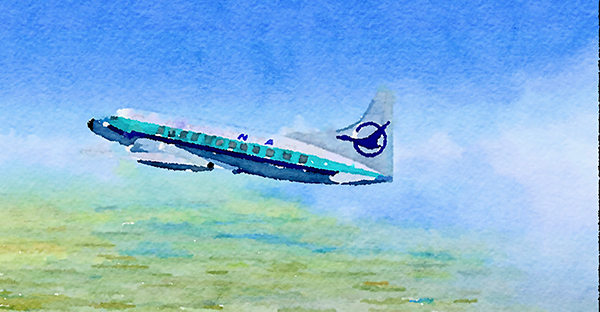
by Dean Zakos
© Dean Zakos. 2023 All Rights Reserved.
Published in Midwest Flyer Magazine February/March 2023 Digital Issue
I was startled awake.
The buzzing alarm clock did its job exceedingly well. It was a raw, windy day in March of 1971, and I needed to get up. The North Central Convair 580 waiting on the ramp would not fly itself. I had been with our “local service carrier” airline since 1964 and sported four silver stripes on the sleeves of my dark blue uniform since the beginning of the year. My days on the line were starting to seem routine, but I also knew each one would be different and distinguishable; schedules, maintenance issues, destinations, weather, and crew personalities all contributed to that.
I made my way to North Central’s Flight Ops at O’Hare, located beneath Gate H1, and signed in at the crew scheduling counter. Today’s flight had us departing from Chicago at 0630, with stops along our route at Milwaukee (MKE), Green Bay (GRB), Menominee (MNM), Escanaba (ESC), and Marquette (MQT). In the afternoon, we would return to ORD by the same route. The weather for the day would be “predictable” for Wisconsin at this time of year; that is, a bit unpredictable. Forecast was scattered clouds over the southern half of Wisconsin; overcast skies, dropping temperatures, and gusty winds landing in Green Bay; and some rain/snow showers and reduced visibility en route to Menominee and Escanaba. Clearing skies in the afternoon.
In 1971, navigation was less sophisticated than it is today. No GPS, just Victor airways and direct routes. A few larger airports we flew into, such as ORD, MSP, DTW, MKE, and GRB, had ILS approaches, but many smaller fields did not. ADFs were still a valuable instrument in the cockpit, as NCA had installed several FAA-approved custom NDB approaches into smaller cities. The approach into Duluth (DLH) was a Precision Radar Approach with military controllers.
North Central had upgraded its fleet in 1967 to include the Convair 580, a turbine-powered conversion of the Convair 440 piston-powered aircraft. The 580 was a big improvement over the 440, with two T56/501 4,000 shaft horsepower Allison engines. An inside joke among NCA personnel was that the airplane was known as the “Converter 580” because of its ability to turn Jet A into pure noise. It was a good airplane that did everything it was asked to do, with long wings, excellent aileron authority, and widely spaced main landing gear. When the FAA certified the turboprop conversion, they required a bungee interconnect between the rudders and the ailerons. We had to contend with the artificial loads imposed on the controls in addition to normal air loads. This resulted in requiring some muscle when landing in strong crosswinds. The wings were a little stiff, often generating pretty solid bumps in turbulence.
The 580 could carry up to 48 passengers and a crew of three: Captain, First Officer, and a Stewardess. And yes, I know they are called Flight Attendants today. In 1971, Flight Attendants wore white hats, dark blue jacket and skirt combos, and white go-go boots. Standing just inside the Convair’s open airstair door boarding passengers on a March day in the Upper Michigan Peninsula, it had to be chilly on bare legs. It was not unusual at NCA to fly with the same FO and FA for the entire month.
As a boy, I never really thought seriously about becoming a pilot. My dad always wanted me to be a doctor. However, my experience in organic chemistry made it clear to me that my best talents were to be found elsewhere.
In college, I participated in the Air Force ROTC program, graduating with a BA degree. Upon graduation, I entered military service. However, not as a pilot, but as a supply officer. I quickly realized who was having all the fun. I applied for pilot training and was accepted. Basic at Williams Air Force Base in Phoenix, flying T-37s and T-38s. Next assignment was to Training Command at Shepard Air Force Base in Wichita Falls instructing in T-37s, then the USAF Reserves.
Walking out onto the ramp at ORD in the early dawn, I looked up at “Herman,” the blue duck painted on the tail of our aircraft. The sun was just beginning its rise over the eastern shore of Lake Michigan. The Convair sat waiting and ready, ground-start cart plugged in, the smell of jet fuel drifting across the ramp. Mechanics and line crew scurried to complete tasks with passengers about to board. I often paid little attention to the North Central logo over those years. I admit now I took it for granted. How I wish I could see that logo again on the tail of a passenger plane.
The First Officer (FO) will be flying this leg. Once I settled into the left seat, the FO and I run our “Receiving Aircraft” and “Before Start Checklists.” Passenger count showed 37 souls joining us this morning. Looking back through the open cockpit door, I could see the rows of twin seats, with ample headroom and leg room compared to today, and the “hat rack” style shelves running the length of the cabin on either side. It is hard to believe now that most men boarding the plane wore suits and ties, most women wore dresses, and many children were dressed as if it was Easter Sunday.
Our clearance out of ORD was “North Central three-four-three, cleared to the Milwaukee airport via left turn after takeoff to two-seven-zero, radar vectors to the Northbrook VOR, then as filed, climb to and maintain five thousand, contact Departure on one-two-six-point-five. Squawk four-three-four-six.” At that altitude, it was easy to watch the cities, rural airports, farm fields, and sectional lines that passed beneath us through scattered clouds. Lake Michigan would be on our right along the route. I was always impressed with the stunning arrays of blue and green hues the sun and clouds produced daily on the water.
After engine start, with my left hand on the nosewheel steering wheel beside my seat, we taxied out to our assigned runway, 32L. We challenged and responded to 18 items on the “Before Takeoff Checklist.” The last item is the annunciator panel located on the center console. We confirmed four amber, six green, and no red lights. We are ready to go.
Upon takeoff clearance from the Tower, we taxi onto the runway. The FO advances the power levers. The Allison T56s respond instantly. Engine vibrations are smooth and steady as we started our rumbling takeoff roll. At 110 knots, I call “Vee One.” At 112 knots, the FO pitches the nose up eight degrees. I confirm positive rate, then the FO calls “gear up,” simultaneously giving a thumb-up with his left hand, as we climbed out over the end of the runway. Passing 130 knots, the FO calls for “METO” power. At 400 feet above the ground, the FO requests “flaps zero,” then calls “climb power.” He then asks for the “Climb Checklist.”
Light but constant winds this morning. While ascending in our left turn, I contact Departure when advised and we are given our next heading. With short flying legs, things happened quickly. Estimated time en route to MKE was only 30 minutes.
The Flight Attendant always had her hands full on such short hops. Barely enough time to serve a tray of pre-poured beverages and get things stowed away before landing.
We are handed off to Milwaukee Approach. I report Mitchell Field in sight. Approach clears us for a visual approach to Runway 1L.
The FO calls for the “In-Range Checklist.” We agree on approach flap settings and approach speeds. At 1,000 feet above the ground, the FO asks for “flaps one-seven,” and then “gear down.” Next, “flaps two-eight,” and we slow to “VRef plus five,” or about 130 knots.
I have seen the view of a runway on final out of a cockpit window countless times, but I never tired of it. The stark blue and white of the sky this morning, the rolling stream of farm fields, roads, and buildings flowing by beneath us, the runway threshold growing larger in front of us, the controlled descent as we managed small adjustments to remain on speed and on glidepath, made each landing at once both familiar and unique.
The FO calls for the “Before Landing Checklist.” I advise Milwaukee Tower, “North Central three-four-three is five miles to the south, inbound on visual approach straight in Runway One Left.” “Cleared to land, winds zero-two-zero at one-two,” the Tower responded.
The Convair brushes onto the runway. First leg complete.
We taxied to Concourse E, known to us as “The Banjo,” and shut down. The FO opened the forward entrance door and airstair. Fourteen passengers deplaned. Eight new passengers boarded. Inside the terminal, as we did at each stop, I checked with Dispatch and reviewed the “Papers,” including weight and balance and a long sheet of teletype paper containing weather and NOTAMs. The fast-moving front, coming from the northwest, was arriving sooner than anticipated. Green Bay’s weather was deteriorating. At our estimated arrival time, forecast was 500 and one in light mist and snow showers. Winds were picking up. My leg to fly.
Time on the ground at MKE was 30 minutes. Then, we were in the air again. Estimated time en route to GRB was 55 minutes, assuming no lengthy vectors by ATC. Climbing out of MKE, Lake Winnebago quickly came into view in the distance off the port wing. The southern half of the lake near Fond du Lac was shimmering in sunshine and scattered clouds, but the northern half was difficult to discern, shrouded in overcast. East of Appleton at 5,000 feet, we were in IMC. There was some light to moderate turbulence. Hopefully, not too many new or white-knuckle passengers on this leg. I asked the FO for current conditions at Green Bay. Ceiling and visibility as advertised, and winds from the northeast, 18 gusting to 28.
Chicago Center tells us to expect the ILS 36 into GRB. We remove the approach plates from our Jeppesen binders and clip them on our control yokes. I begin the briefing by identifying the exact name and date on the plate. I then call out the localizer frequency, approach course, runway length, touchdown zone elevation, approach and runway lights, and crossing altitude at the Final Approach Fix (FAF). Next, I review the Decision Height (DH), minimum visibility, and the missed approach procedure. I always thought a good briefing was essential to functioning as a team.
We are handed off to Green Bay Approach. After vectors and a descent to 2,700 feet, the call comes from Approach, “North Central three-four three, turn left to zero-three-zero to intercept the localizer. Maintain two thousand seven hundred until established. Cleared ILS Three-Six approach. Contact Tower on one-one-eight-point-seven.” As the First Officer read back our clearance, we commenced our turn. We contacted Tower. Winds were 035 at 15, gusting to 26. The ADF needle is pointing to the Locator Outer Marker. The localizer indicators on the HSIs in our panel soon started to center. Cross the Final Approach Fix and center the glide slope pointers at 2200 feet. Decision Height is 884 feet. I retard the power levers to idle. Pre-landing checks complete. Flaps at 17. We started down. Precipitation on the windshield. Outside air temp below freezing. Confirmed anti-ice “On.” At DEPRE, the Final Approach Fix, I call for “gear down,” then request the “Landing Checklist.” Next, “flaps 28,” and adjust the power levers to maintain VRef plus 10 knots.
The FO is dividing his attention between looking ahead through the windshield and checking his HSI, airspeed, and altimeter. I was on the gauges. My eyes darted across my side of the panel: artificial horizon; HSI; altimeter; artificial horizon again; airspeed; HSI again. Correcting. Kept my scan going. Rate of descent 600 feet per minute. Steady. Gusts buffeting us. Scanning the instruments. Crabbing to the right. Correcting. Bracketing the heading to stay on the localizer.
The FO makes his first call-out, “one thousand.” He was staring intently out the windshield, pausing only to shift his eyes to read his instruments. No ground contact or runway yet. Ceiling was supposed to be 500 feet above ground level, or 1200 feet on the altimeter, but so far only wet, gray nothingness illuminated by our landing lights. We are on localizer and glide slope. Speed is good. Descent rate good. Continuing. If we do not see the runway at minimums, we will go missed and sort this out. About 2.5 miles to the runway threshold.
If you are wondering, my hands and forehead were dry. I did not feel relaxed, but I was not nervous. I felt alert and ready – and alive! One of the things I liked best about flying is how it focuses your concentration. An ILS approach to minimums will do that. All of my senses were fully engaged. I have done this before; I am good at it. Hours and experience make a large difference in comfort level and confidence. I was ready to land or, if the runway did not appear in front of us at DH, I was prepared to go missed. Our training, standardization of procedures, and experience made both options equally possible and safe.
“Two hundred,” the First Officer calls out. “One hundred . . . .” Then, “Runway in sight. Minimums.” I looked up from the panel and appearing through the rain-and-sleet-spattered windshield were the approach lighting and runway. Lights were up full. We were on the centerline. Slightly lowered the right wing. Rocking a bit with the gusts. Careful. I do not want to pick up the wing. Over the runway, I pull the power levers to idle. Crabbing over the centerline, nose into the quartering winds, bleeding off airspeed. Now, pushing left rudder hard to straighten out and track the centerline. A moment later, the right mains screech, lightly bounce once, and then make solid contact with the pavement. The left mains quickly follow and plant firmly. Yoke full right. Hold the nose off. Hold it. Now, let it down gently on the runway centerline.
I call “flaps up” and draw the power levers back and up, over the detents, moving the props into reverse pitch. We slow quickly, bouncing and swaying in our seats, forward momentum pressing us against our shoulder straps as each prop’s four big, rectangular blades push hard opposite the oncoming air. I do not need to touch the brakes. Up ahead, the turn off to the taxiway. Despite wet, slick conditions, we will easily make the exit. For a second, I think to myself, “My dad would be proud.”
There was a delay to our departure from GRB, as the ground crew addressed a minor mechanical issue with a cargo door latch. NCA owed much to the ramp agents, dispatchers, and ground personnel for our enviable “on time” record. Weather forecast now says conditions are improving. Low clouds and precipitation will move off to the east within the hour. We were on to Menominee, Escanaba, and Marquette, arriving MQT at 1230. To save time, we called ahead to the ramp agent at MQT and put in our orders for malts and cheeseburgers at our favorite local restaurant. Lunch at MQT will be quick, but still time enough to eat, laugh, and tell a few stories or discuss the news of the day. We will depart Marquette at 1335. For the return legs, we will make stops again at Escanaba, Menominee, Green Bay, and Milwaukee, arriving O’Hare at about 1845 local.
If you are counting, in a mix of VMC and IMC conditions, that is 12 takeoffs and landings. Several instrument approaches, one to minimums. With vectors and some headwinds, about 6 hours and 45 minutes of actual flying time in 12 hours. All in a day’s work.
I was rudely awakened by a lot of alarm clocks over the years. I went on to have a satisfying career in the airline business, despite competition, management shake-ups, mergers, and the sometimes-fickle flying habits of the public, retiring as a senior captain on a Northwest Airlines DC-10. Just for fun on weekends, I flew Lockheed C-130s for the USAF Reserve’s 440th Airlift Wing out of Mitchell Field in Milwaukee.
Shutting the big Allison turbines down on the ramp at ORD, I sit in the cockpit for a moment watching out my side window as the four squared-off paddle blades spin down and slowly stop turning. The night sky was clear, cold, and black, with stars beginning to shine through wispy streaks of high cirrus clouds. I smile, remembering something a wise old NCA captain once said to me at the end of long and trying day when I was starting out. “Cheated death again,” he joked. We both laughed.
Every day since I started flying, I was always willing and happy to do that.
EDITOR’S NOTE: Dean Zakos (Private Pilot ASEL, Instrument) of Madison, Wisconsin, is the author of “Laughing with the Wind, Practical Advice and Personal Stories from a General Aviation Pilot.” Mr. Zakos has also written numerous short stories and flying articles for Midwest Flyer Magazine and other aviation publications.
DISCLAIMER: Mr. Zakos’ articles involve creative writing, and therefore the information presented may be fictional in nature, and should not be used for flight, or misconstrued as instructional material. Readers are urged to always consult with their personal flight instructor and others about anything discussed herein.
